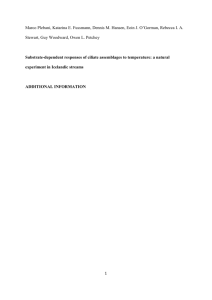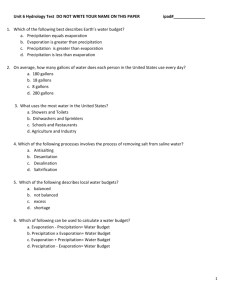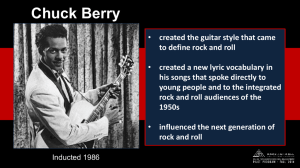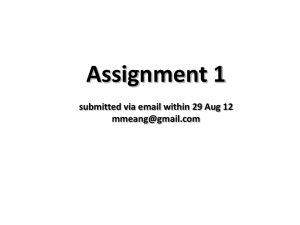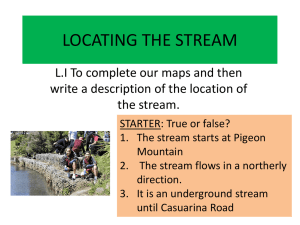Ch 15-River Systems
advertisement
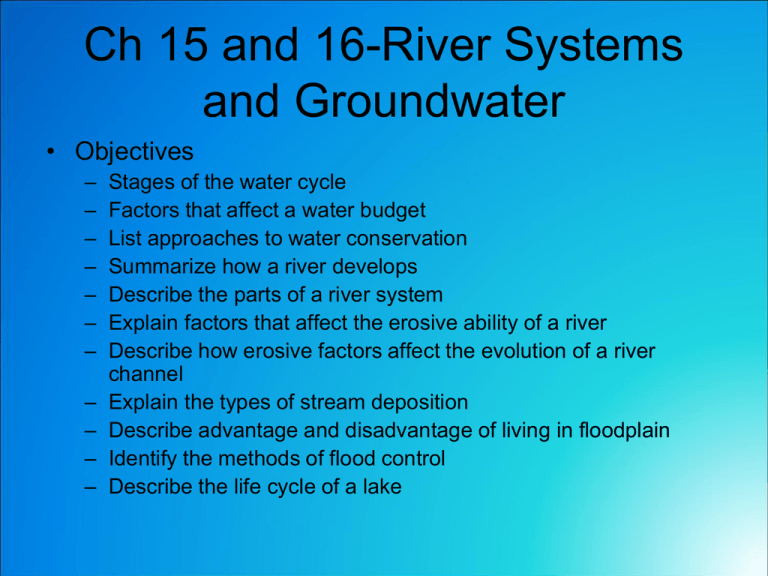
Ch 15 and 16-River Systems and Groundwater • Objectives – – – – – – – – – – – Stages of the water cycle Factors that affect a water budget List approaches to water conservation Summarize how a river develops Describe the parts of a river system Explain factors that affect the erosive ability of a river Describe how erosive factors affect the evolution of a river channel Explain the types of stream deposition Describe advantage and disadvantage of living in floodplain Identify the methods of flood control Describe the life cycle of a lake Movement of Water on Earth • Water vapor-water that occurs as invisible gas in atmosphere • Water cycle-continuous movement of water between the atmosphere, land, oceans • Evapotranspiration-total loss of water from an area – Evaporation-liquid water changes into water vapor. Where does the most evaporation take place at? – Transpiration-plants release water vapor • Condensation-gas to liquid – Water on outside of glass – Tiny liquid water droplets and forms clouds • Precipitation-water falls from clouds – 75% falls on oceans – Examples Water Budget/Use • Water budget established by water cycle – Factors that affect it include; temperature, vegetation, wind, and amount and duration of rainfall. How are these factors? • Average person uses 95,000 L each yr. What is it used for? 90% of water used in cities, returned to rivers and oceans as wastewater – Some may contain harmful materials Water Conservation • What is water conservation? – The wise use of water resources – How can people conserve water? • How can governments conserve? – Enforcing conservation laws and antipollution laws that prohibit dumping of waste into bodies of water – Finding alternative ways to obtaining fresh water • Desalination-process of removing salt from ocean water – Expensive and impractical Stream Erosion • How does a river develop? – Soil collects water, runoff begins from excess water, erodes rock and soil, forms narrow ditch. Precipitation and erosion form valley w/ permanent stream • Parts of River System – Tributaries-feeders streams into main stream – Watershed-land that is drained by river system – Divides-ridges or elevated regions, separate water sheds – Channel-narrow depression stream follows downhill – Banks-edges of stream above water level – Bed-the part of stream channel below water level Channel Erosion • Stream Load-materials other than water carried by stream – Suspended load, bed load, dissolved load • Stream Discharge-volume of water that flows w/in given time • Stream Gradient-change in elevation over given distance. Velocity depends on gradient Evolution of River Channels • As the stream’s load, discharge, and gradient decrease, the erosive power of the stream decreases • Channels erode, become wider and deeper=rivers • Meander- one of the bends, twists, or curves in lowgradient stream or river. – More energy directed to banks than beds. – Faster on outside of curve, sediment deposited to form sand bars – Oxbow Lake-the meander becomes isolated from river • Braided Streams-multiple channels, divide or rejoin around sediment bars – Large sediment load, coarse sand and gravel – Build up on channel floor Oxbow Lake Stream Deposition • Types of stream deposition – Deltas-fan shaped mass of rock material deposited at mouth of stream • Waves, tides, offshore depths, sediment load – Alluvial fan-fan shaped mass of rock material deposited by stream when slope of land decreases sharply • Form when streams flow from mts to flat land Floodplains • What is a floodplain? – Area along river that forms from sediments deposited when river overflows its banks – Natural levees • Advantage – Convenient access to river for shipping, fishing, transportation – Rich soils, good for farming • Disadvantage – Swampy areas – Flooding homes Flood Control • Name some things that could prevent flooding – Forest and soil conservation measures – Artificial structures – Dams – Artificial levees, artificial lakes – Permanent overflow channels or floodways Life Cycle of Lake • Most lakes located in high latitudes and mountainous areas • What are some sources of lakes? – Springs, rivers, runoff – Most comes from precipitation and melting of ice and snow – Short in geologic terms. Why? Properties of Aquifers • Groundwater-water beneath the Earth’s surface, fills fractures and cavities in rock • What is an aquifer? – Body of rock or sediment in which large amounts of water can flow and be stored – Factors that affect flow of water-porosity and permeability • Porosity – Percentage of total volume of a rock or sediment that consists of open spaces – Sorting, particle packing and grain shape • Permeability – Ability of rock or sediment to let fluids pass through its open spaces or pores – Size and sorting, open spaces must be connected Zones of Aquifers • Zone of saturation-layer of aquifer in which the pore space is completely filled w/ water • Zone of aeration-lies between the water table and Earth’s surface – Top layer holds soil moisture – Bottom region above water table is capillary fringe – Dry area in between fills w//water when it rains • Water table-upper surface of underground water • Recharge zone- anywhere that water from the surface can travel through permeable rock to reach an aquifer Wells and Springs • Well-hole that is dug to below level of water table and through which groundwater is brought to Earth’s surface • Cone of depression- water table lowers below the well, it goes dry • Spring-Natural flow of groundwater to Earth’s surface in places where ground surface dips below water table • Artesian formation-sloping layer of permeable rock sandwiched between 2 layers of impermeable rock and exposed at surface – Source of water for some springs • Artesian well-well through which water flows freely w/out being pumped Hot Springs and Geysers • Hot springs-groundwater is heated when it passes through rock that has been heated by magma – At least 37 deg C and rises to surface before cooling • Geysers-hot springs that periodically erupt from surface pools or through small vents – Narrow vent that connects 1 or more underground chambers w/ surface Results of Weathering by Groundwater • Caverns-large cave that may consist of many smaller connecting chambers – Carbonic acid slowly dissolves the limestone and enlarges cracks in the rock • Stalactites-suspended cone-shaped deposit of calcite on ceiling of cavern • Stalagmites-upward pointing cone of calcite on floor of cavern • Sinkholes-circular depression that forms at the surface when rock dissolves, when sediment is removed, or when caves or mines collapse • Natural bridges-uncollapsed rock between each pair of sinkholes forms an arch of rock
